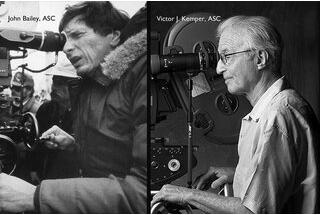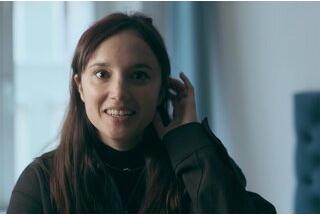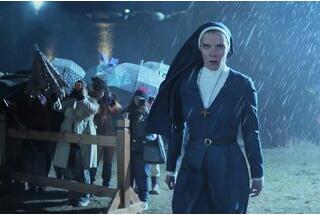Lennert Hillege, NSC, speaks about the challenges of shooting "Occupied City", by Steve McQueen
Time After Time, by François ReumontHow did you end up working on this film?
Lennert Hillege: Steve McQueen and I are pretty much neighbours, and sometimes we bump into each other in the supermarket! But all jokes aside, the ’Family Affair Films’ producer, Floor Onrust, is an old acquaintance. We met in film school and she introduced me to Steve, so that’s how the relationship developed with Steve and his wife, Bianca Stigtert, who is also Dutch and the author of the book on which the film is based.
The book is a very factual and cold analysis of the events that happened in the capital, similar to a phone book. Each address is listed, with a description of what happened without any emotional or dramatic tone.
How did you approach such a project?
LH: LeThe filming was spread over almost three years, in blocks, by adapting our shoot to the events happening around us. The book served as a guide which listed all the addresses, some of which necessarily required more preparation than others (the museum, the concert hall, etc.), but it was above all a sort of ’marathon’, given the considerable number of places listed in the book. In fact, we shot much more than the 4-hour version presented on the Croisette. The full version of this project might be released later, in a much longer format...
Something striking when you see the film is the human element. In almost every shot, something happens. Sometimes it seems insignificant, sometimes it seems to be a rare moment, as for example the bicycle accident that you filmed in a street at night.
LH: We tried to be as in tune as possible with the Amsterdam lifestyle, day by day. Whether a demonstration breaks out, or snow falls, ice... we asked ourselves on a daily basis what could happen and if we could incorporate it into our work. Of course, at the beginning, it was quite easy because we had so many different places to film, and as many options for our work plan. But as the movie progressed, things became more complex to manage, with the last few locations. The other thing about shooting over such a long period is that you get better at it. With the team, we developed a whole bunch of techniques, and ways of behaving with the locals. At the end of the film, surprisingly, we had become almost completely invisible.
What were the guidelines at the beginning?
LH: Nothing was very clear. It definitely wasn’t like preparing for a rocket launch! The film was built up progressively during all the months of work. Mostly, thanks to the fact that Steve had decided to work on the editing at the same time as we were filming, using this editing as a support for our work. Every two weeks or so, a screening of the editing was organised and we would exchange ideas together with this groundwork, thinking of all the details which progressively gave life to the film. The different layers of the film, – the sound, the image and the voice of the film – would prompt us to choose a direction or another. In a way, I noticed that these sessions became a privileged moment in the making of the film. They became as important as the shooting, if not more, as the shoot was by nature much more ’in the moment’. In hindsight, this very particular way of making a film over a long period of time, with us evolving with it, was like making a good wine... Perhaps it’s still too early to taste it! Will we have to wait ten or twenty years to taste its true flavour? Capturing time is not so easy.
Nevertheless, the last sequence, in the synagogue, clearly showcases the film’s conclusion...
LH: Yes, that scene was shot at the very end. I think it was a very conscious decision on Steve’s part. We didn’t know at the beginning of the shoot if there would actually be a final scene. It’s not easy to move forward on a project, not knowing wether there’s an end to it or not. We could have decided to work by seasons, geographically, or by organizing the addresses in alphabetical order... But all of these questions merged into emotion once we started to shoot. And into the connections we were going to create between the past and the present. If we’d given too much order to this project, it would have ended up like a traditional documentary. And talking about that final scene in the synagogue, it was a way to give an end to the experience. To suddenly break the state of hypnosis, and tell the audience that it was time to go home.
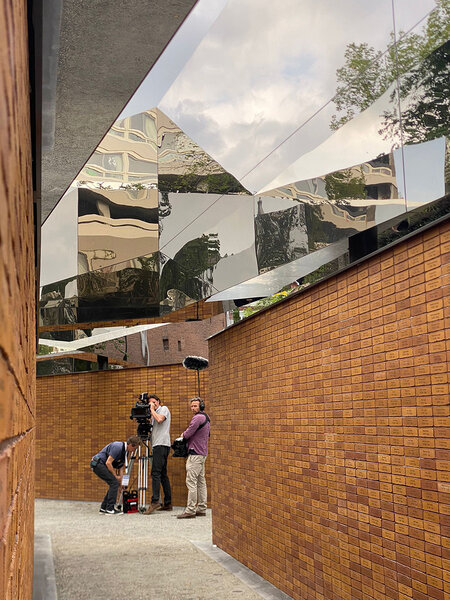
There were three kinds of shots in the film. Those like the first shot, which almost seemed to be like fictional staging; those that were strictly in line with TV news; and those that were much more dreamlike, in which reality was left behind...
LH: It was completely dependent on the location and the subject.
That first shot, with the woman going down that trapdoor, was an action we could easily plan, as it was a daily routine for her. In that category of shots or sequences, the camera movement or the scenography becomes more or less meaningful.
Then, there were indeed sequences that were filmed in a very frontal and raw way. The demonstrations, or the commemorations with the King for example.
And, as you have noticed, there were shots where we would go somewhere else, where nothing was actually happening. We called them our ’lullaby shots’, intended to take the viewer into hypnosis. You know, we spent so much time in the city... it became almost hypnotic for us too when we were making the film. In those moments, the city’s music or atmosphere would sometimes replace the voice-over.
Weren’t you afraid at times to be making images that were too ’touristy’?
LH: The sequences shot in famous places, like the museum for example, were risky from this point of view. But they have to be seen in the context of the whole project, and of the countless places we filmed in, even though we didn’t keep everything in this 4-hour version. The fundamental problem with these well-known places is that you, as a viewer, immediately recognise what you are looking at. And that’s not good... That’s not the spirit in which we shot the film. That’s probably why Anne Frank’s secret annex, one of the most emblematic places of that time, was not kept in the edit, although it was obviously listed in the book.
Did you have to do retakes for certain places?
LH: It happened sometimes. Mainly because when we looked at the edit we would suddenly realise that the camera or the crew was becoming too present. The interference with what we were filming would sometimes become too obvious, the people in front of the camera realising that they were being filmed and more or less starting to act. The childlike innocence we were looking for would be gone. But there weren’t really any rules, or models, it really depended on each situation.
Let’s talk about the camera!
LH: When the production started talking to me about the project, I immediately wondered what equipment I should use to shoot. The big uncertainty was the schedule, as nothing specific could be decided. I already imagined myself waking up in the middle of the night to shoot a sequence on Amsterdam life.
The only thing that was certain was that Steve wanted to shoot in 35mm film. There was never any debate about this, it was a given. Both for the rendering, for the memorial aspect of the project, and above all to place the shoot in a completely opposite approach to what we see these days with digital. Thinking about the shot before rolling the camera, focusing more on set, and filming less useless stuff, making it easier for the editing... So, in order to be as autonomous and as ready as possible for a shooting period that would be very uncertain, I decided to buy a camera myself and to have it available at all time during those three years.
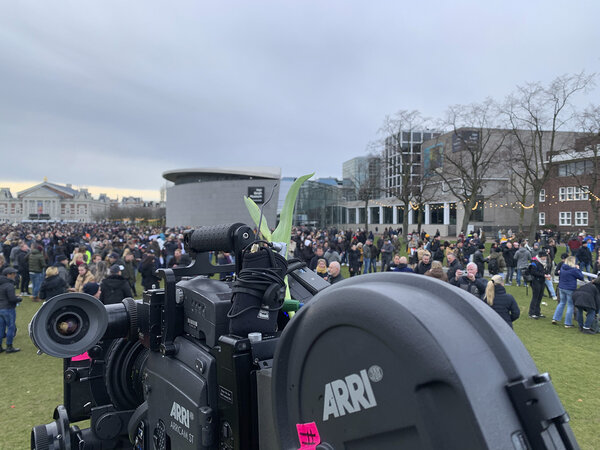
Who did you buy it from?
LH: From a person who played a fundamental role in the making of the film: Danny Van Deventer, the manager of Cinefacilities in Amsterdam. He is a true character, who owns one of the last places entirely dedicated to film in Europe. He’s passionate about film cameras and collects them, as well as being an excellent camera assistant! In fact, he was the one who worked with me on the shoot. With his help and technical guidance, we put together the ideal 35mm film camera for this project. A camera that was robust and reliable enough to shoot long rolls of film over three years. And extremely quiet, so that it would be as unnoticeable as possible, even in the very quiet interiors that we often encountered during the shoot. The camera was also specially fitted with a 1.33 mm Full Frame ground-glass. I thought we needed to use the broadest possible image surface to record as much of the reality around us as possible.
When you see the film in theatres, it’s hard to notice that it’s celluloid... there is almost no grain in the image...
LH: Yes, the film was approved in 4P, and the first few weeks I was very surprised by the feel and definition in the image. I used the full range of Kodak stock available, according to the needed sensitivity, and the film texture became practically unnoticeable. The transfer to digital was as neutral and transparent as possible. I think that this concept of ’texture’ which we attribute to celluloid film has a lot to do with the use of 3P or 2P, popularized since the advent of digital; or, when there’s ’grain’ in the image, and that it moves, it ’has to be’ celluloid film.
In terms of lenses, I chose to fit the camera with Leica Summilux lenses, to stay in this philosophy of capturing ’realism’. We wanted to have an extremely simple and beautiful base for this film.
No zoom?
LH: I installed a zoom lens once or twice for practical reasons (the King’s visit for example, filmed with the press, or the sequence filmed on a boat). But otherwise the whole film was shot with prime lenses, the longest lens being the 135mm.
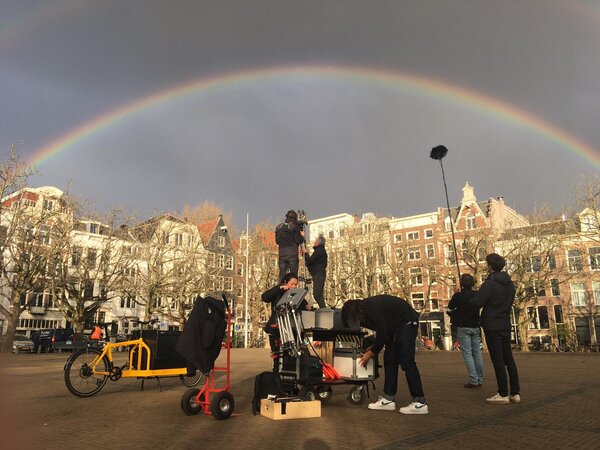
How were you able to keep a certain lightness while being with a film crew?
LH: We gradually developed our own little travelling ’film circus’, which we transported on bikes - Dutch style guaranteed! The second camera assistant followed us in a small van which we turned into a darkroom to load and unload the camera magazines. We were really mobile, and extremely reactive despite the difficulties of moving around in a big city like Amsterdam. As an example for some days on the shoot, we’d start with a quick location scouting, followed by a few handshakes with the locals, while we’d be setting up the equipment. Then, we’d film shot after shot with great flexibility and with overwhelming spontaneity. The team was composed of my two assistants, the sound engineer, and an assistant director who took care of the relationships with the locals, such as getting them to sign image rights, and above all checking that we were at the right address. The book lists about 2.000 places, and so many have disappeared, been renamed... it was almost like detective work!
Wasn’t it a bit scary, given the length of the film and the complicated period you were shooting in?
LH: It was my first time working on a documentary. Naturally, I was a little worried about how an atypical project like this would go. In the end, on the 500km of negative footage we shot, we had no issues. Maybe a little on one shot... but that’s it.
At the same time, putting things in context, we weren’t filming Tom Cruise on the next Mission Impossible. A moving shot wouldn’t have been such a disaster, as we could probably have filmed it again the next day.
Our latest photochemical lab in the Netherlands - Haghefilm digital - took on the job, partly working in association with the Belgian lab Color By Dejonghe, as Haghefilms was moving to Gouda, one of the suburbs of Rotterdam.
Will you miss this incredible freedom?
LH: This film was like a big reset for me. Usually when you want to start a project, you have all these levers that you are supposed to look at. For example, who the viewers will be, what kind of film it is, the distributor suddenly demanding this or that.... On “Occupied City”, there was none of that. Steve created a pressure-free atmosphere. I almost felt like a child, free to do what I wanted. Having a sensory approach to the project, without references or counter references. Having an experience like this felt very special; making a film on such a long time span, and having the chance to be so open with the director.
- Danny Van Deventere, Cine Facilities Amsterdam
Danny is a camera assistant, rents equipment, and is an expert in maintenance and repair of film cameras. He is passionate about film photography and has been fighting for the protection of film cameras, the know-how and equipment around them, since the advent of digital technology on sets.
You are one of the last remaining film-only rental companies... how is this still possible in 2023?
Danny Van Deventere: Although the digital wave has completely taken precedence since 2009, some of the great Hollywood directors such as Spielberg, Nolan or Tarantino still continue to shoot with film against all odds. But beyond these prestigious exceptions, we’ve noticed in the film rental community that demand has been picking up again in the past six years. This phenomenon has been boosted by an increased demand from the younger generation, who are interested in the analogue way of making films, usually because they have never experienced it. Thankfully, Kodak didn’t stop producing film when demand was low, and there are still laboratories that know how to process it. Nevertheless, I am concerned about the availability of the remaining cameras on the market, and especially about the know-how and parts needed to maintain them. This is a subject that I think the cinematographers’ associations should talk about.
Tell me about the preparation of the film.
DvD: Lennert came to me in 2018, long before "Occupied City" started. The project was in its infancy, and he immediately told me about the main challenges of this unusual shoot. The length, of course, which was still rather vague at that stage - but which would inevitably be substantial given Bianca Stigtert’s book. He immediately talked to me about buying a camera himself so that he would always have it available, and together we looked for the ideal model for this film.
Which cameras were considered?
DvD: The Aaton35 was the camera I thought of recommending to him at first. By far the most compact, the lightest and the most suitable for documentary work. But its insufficient quietness of operation put it somewhat out of favour for this project. Indeed, Steve McQueen wanted to shoot indoors, – sometimes in total discretion –, and only a really silent camera could make this film. We therefore decided together to start with an Arricam ST body (one of the most recent film cameras to have been designed and manufactured). We changed the configurations, notably by minimising them as much as possible; – as usually the options were very broad, because they were made for filming in studios. This work was organised both around the magazines (by adapting the light 400’ magazines of the LT model) but also on the viewfinder, making it more compact and setting it in Open Gate mode. This way, the printed image area was as large as possible. The final result was then much more defined.
And you yourself were the camera assistant on the film...
DvD: Yes, I assisted Lennert on the film. At first, shooting a film, even over several years, in your own city, seemed pretty cool. The whole crew was on bicycles, and we just had my little camera van, which was parked nearby every day to bring in the crates, and later to serve as a base for the second assistant with his loading tent. But I have to admit that this was the most physical and challenging shoot of my entire career. Just to give you an idea, I ran the equivalent of two marathons (44 km) on this film, with the camera on my shoulder. Even when we filmed in places we knew very well, we had to constantly be on the lookout for what was happening around us. Every day, incredible things happened in front of us. Whether it was after an hour or two minutes... it was crazy and wonderful. This relationship with time was both splendid and exhausting.
(Interview conducted by François Reumont and translated from French by Chloé Finch, for the AFC.)
 En
En
 Fr
Fr
